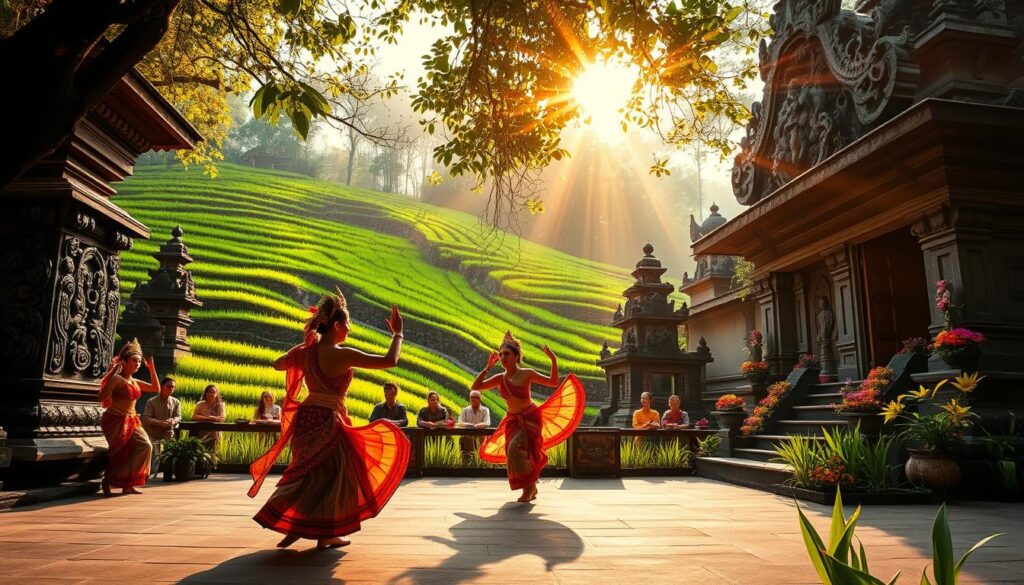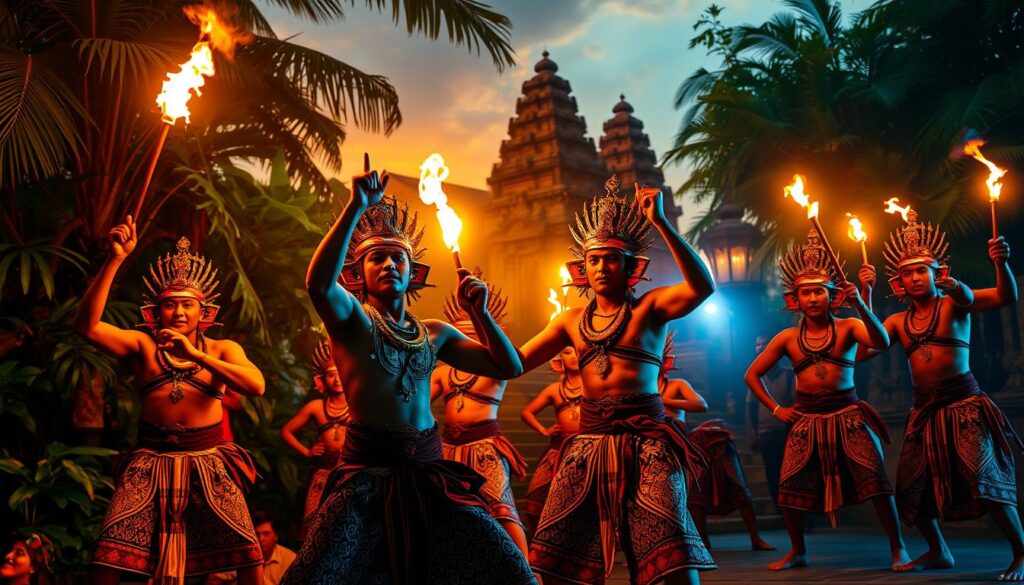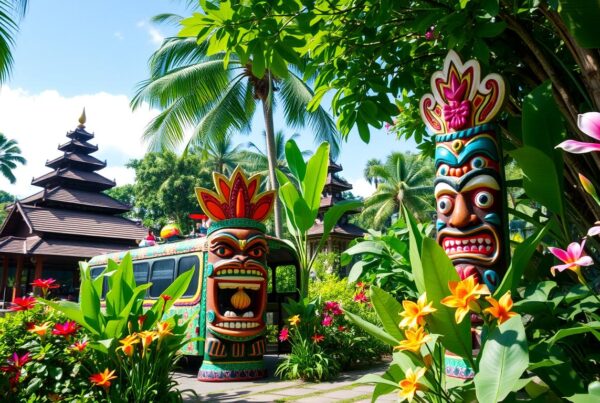G’day, mate! Ubud, Bali’s artistic heart, is bursting with traditional dances and sacred temples. This cultural hotspot showcases the island’s rich heritage, rooted in Hindu rituals and ancient customs.
Balinese culture blends influences from India, China, and Java. Migrants brought their beliefs to the island over 2,000 years ago. This created a unique mix of Hindu traditions and Javanese elements in Ubud’s arts scene.
In Ubud, traditional dances tell ancient stories through graceful movements. Temples serve as divine gateways, where rituals and dance intertwine. The Legong’s elegance and Kecak’s hypnotic chants offer glimpses into Bali’s spiritual world.
Explore Ubud’s stunning temples to witness this cultural fusion firsthand. Here, you’ll see how dance and ritual blend seamlessly in Balinese traditions.
Key Takeaways
- Ubud is the cultural epicentre of Bali, known for traditional dances and temples
- Balinese culture blends Hindu and Javanese influences
- Traditional dances in Ubud showcase ancient stories and spiritual beliefs
- Temples in Ubud play a crucial role in Balinese cultural practices
- Experiencing Ubud’s arts scene offers insight into Bali’s rich cultural heritage
Introduction to Balinese Culture
Balinese culture is a tapestry of ancient traditions, spiritual practices, and artistic expressions. It sets Bali apart as a jewel in Indonesia’s crown. Visitors are captivated by its depth and vibrancy.
The roots of Bali’s cultural heritage
Bali’s cultural roots are influenced by indigenous beliefs and external influences. Rituals and ceremonies mark every aspect of life on the island. From birth to death, intricate ceremonies celebrate each milestone.
Influence of Hinduism and Javanese traditions
Hinduism shapes Balinese culture significantly. The 2010 census shows 83% of Balinese are Hindu. This makes Bali the only predominantly Hindu island in Indonesia.
Balinese Hinduism is unique, blending with Javanese traditions. It influences nearly every aspect of life on the island.
The importance of ancestors and spirits in daily life
Spiritual practices are woven into daily life in Bali. The concept of Tri Hita Karana, or “Three Causes of Goodness”, is central. It emphasises harmony between humans, nature, and the divine.
Daily offerings, called “canang sari”, are common. They symbolise the deep connection between Balinese people and their spiritual world.
“In Bali, life is a beautiful dance between the seen and unseen worlds.”
Over 20,000 Hindu temples dot Bali’s landscape. Each temple celebrates its anniversary, or odalan, every 210 days. This showcases the cyclical nature of Balinese spiritual life.
Bali’s unique cultural identity continues to thrive. It offers visitors a glimpse into a world where tradition and spirituality blend seamlessly.
The Spiritual Significance of Dance in Bali
Balinese dance is sacred in local culture, deeply rooted in Hindu rituals. These dances link the earthly and celestial realms. They embody Bali’s rich cultural heritage.
Dance as a Form of Divine Communication
In Bali, dance is seen as a gift from the gods. Dancers channel divine energy in performances linked to temples and deities. UNESCO recognized this spiritual connection in 2015.
The Concept of Taksu: Divine Inspiration in Performance
Taksu is a unique Balinese concept of divine inspiration in dance. Dancers pray before shows to receive this spiritual energy. It’s believed to enhance their artistry and deepen connections.
The Role of Offerings and Prayers in Dance Rituals
Balinese dance performances start with an offering, highlighting their spiritual nature. These rituals include purification ceremonies and specific hand movements called mudras. This preparation shows dance’s role as a sacred practice in Balinese Hindu rituals.
| Dance Category | Purpose | Spiritual Significance |
|---|---|---|
| Wali | Sacred dances | Performed in inner temple courtyards |
| Bebali | Semi-sacred dances | Accompany ceremonies in middle courtyards |
| Balih-balihan | Entertainment dances | Performed in outer courtyards for public |
These dances blend art and spirituality in Balinese culture. They offer a unique glimpse into the island’s rich spiritual practices. Balinese dance remains central to Hindu rituals on the island.
Traditional Balinese Dances: A Window into Mythology
Balinese dances offer a peek into ancient myths and legends. They bring Hindu epics to life through intricate movements. Dancers use their bodies, faces, eyes, and hands to tell stories.
Balinese kids start dancing young. Girls begin hand movements at 4 or 5 years old. This helps keep their cultural heritage alive for future generations.
Gamelan music adds to the rich experience of these dances. The mix of visual storytelling and music creates a magical atmosphere. It takes viewers to a world of myth and wonder.
“Balinese dance is not just movement; it’s a living, breathing connection to our ancestors and gods.”
Different dances have special meanings in Balinese mythology:
- Barong: Symbolises the eternal struggle between good and evil
- Legong: Showcases grace and elegance, led by three young female dancers
- Kecak: Features a choir of bare-chested men, telling the Ramayana epic
- Baris: A warrior dance depicting the might of Balinese kingdoms
| Dance Type | Origin | Key Feature |
|---|---|---|
| Barong | Ancient Balinese mythology | Symbolic battle of good vs evil |
| Legong | Royal courts of Bali | Intricate finger movements |
| Kecak | 20th century Balinese adaptation | Chanting male chorus |
These dances do more than entertain. They keep Balinese culture alive and thriving. Each year, they draw many visitors to Bali. This boosts the island’s cultural tourism industry.
Ubud: The Cultural Heart of Bali
Ubud is a cultural gem in Bali’s lush highlands. This charming town is famous for its artistic spirit. Visitors flock here to experience Ubud’s unique blend of arts, dances, and heritage.
A Hub for Traditional Arts
Ubud’s artistic roots stretch back to the 1930s. Galleries, museums, and studios are scattered throughout the town. The Agung Rai Museum of Art and Neka Art Museum display both classic and modern Balinese art.
These venues offer a peek into Bali’s rich artistic traditions. Visitors can explore centuries of creativity in one place.

Best Venues for Dance Performances
Ubud Palace is the top spot for traditional dance shows. Nightly performances bring ancient stories to life. Visitors can enjoy Legong, Barong, and Kecak dances.
The palace is open daily from 8 AM to 6 PM. Dance shows usually start at 7:30 PM and last 90 minutes.
Combining Performances with Temple Visits
Ubud is home to many temples, each offering insight into Balinese spirituality. The Sacred Monkey Forest Sanctuary and Pura Taman Saraswati are must-see attractions.
Combining temple visits with dance shows gives a full taste of Ubud’s cultural heritage. It’s the perfect way to experience Bali’s traditions.
| Venue | Opening Hours | Performance Time | Distance from Ubud Art Market |
|---|---|---|---|
| Ubud Palace | 8 AM – 6 PM | 7:30 PM – 9 PM | 2-minute walk |
| Sacred Monkey Forest | 8:30 AM – 6 PM | N/A | 15-minute walk |
| Pura Taman Saraswati | 7 AM – 5 PM | 7 PM – 8 PM | 5-minute walk |
Legong: The Epitome of Balinese Grace
Legong dance is a jewel in Bali’s traditional dance crown. It captures Balinese culture’s essence with elegant, precise movements. This graceful performance captivates audiences worldwide.
The Story Behind Legong
Legong originated in the 19th century, telling tales from Balinese mythology. The most common story features a bird warning a king against war. Intricate movements bring this narrative to life, showcasing Bali’s rich storytelling tradition.
Characteristics of Legong
Young girls typically perform Legong, wearing elaborate costumes and headdresses. Their precise, fluid movements embody the grace of Balinese art. The dance usually features three performers: two Legongs and an attendant called Condong.
Where to Watch in Ubud
Ubud’s arts scene offers several venues to experience Legong. Popular spots include Ubud Palace and Cafe Lotus at Ubud Water Palace. Performances often take place on Tuesdays and Saturdays, starting around 7:30 pm.
| Venue | Performance Days | Start Time |
|---|---|---|
| Ubud Palace | Tuesday, Saturday | 7:30 PM |
| Cafe Lotus Ubud | Tuesday, Saturday | 7:30 PM |
A Legong performance offers a unique glimpse into Balinese culture. Its beauty and symbolism make it a must-see attraction. Don’t miss this chance to explore Ubud’s rich artistic traditions.
The Hypnotic Kecak Dance: A Unique Balinese Experience

The Kecak Dance is a captivating Balinese performance. It evolved from ancient trance rituals. Unlike other dances, Kecak doesn’t use Gamelan Music.
Instead, up to 100 shirtless men create a hypnotic soundtrack. They chant “cak-cak-cak” and clap rhythmically. This unique chorus is known as gamelan suara.
The dance originated in Batu Bulan village in the 1930s. It portrays scenes from the Hindu epic Ramayana. The story often focuses on Prince Rama’s rescue of Sita.
Visitors can see this spectacle across Bali. Ubud’s Pura Dalem Taman hosts shows on Wednesdays and Saturdays. For a stunning view, watch it at Uluwatu Temple during sunset.
| Venue | Performance Days | Ticket Price (IDR) |
|---|---|---|
| Uluwatu Temple | Daily | 100,000 |
| Ubud (Pura Dalem Taman) | Wednesday, Saturday | 75,000 |
| Tanah Lot | Friday, Saturday, Sunday | 100,000 |
To enjoy this cultural gem, come early and dress respectfully. Don’t forget to bring cash. The Kecak Dance offers a glimpse into Bali’s rich traditions.
Barong and Rangda: The Eternal Battle of Good vs. Evil
Balinese culture showcases captivating Traditional Dances that bring ancient myths to life. The Barong and Rangda dance stands out as a powerful representation of good versus evil.
The Mythological Significance
In Balinese Hindu Rituals, Barong represents good, often depicted as a lion-like creature. Rangda, a menacing old woman, embodies evil. Their battle symbolises Rwa Bhineda, the balance of opposing forces in life.
Structure and Elements of the Barong Dance
The Barong dance is vital to Balinese Culture. Two dancers animate the Barong costume, bringing the benevolent spirit to life. Other performers represent characters from Balinese mythology.
The dance unfolds as a gripping narrative. It showcases the eternal conflict between light and darkness.
The Dramatic Keris Dance
The Keris dance is a performance highlight. Male dancers, seemingly in a trance, attempt to stab themselves with traditional daggers. Miraculously, they remain unharmed, showing good triumphing over evil.
This powerful display reflects deep-rooted spiritual beliefs. These beliefs are central to Balinese Hindu traditions.
The Barong and Rangda dance offers a mesmerising glimpse into Balinese mythology. It’s a must-see for anyone curious about Bali’s rich cultural heritage.
Temples of Ubud: Sanctuaries of Balinese Culture
Ubud’s temples are living testaments to Balinese culture. They blend Hindu rituals with indigenous architecture. These sacred spaces, called ‘pura’, are the heart of Bali’s spiritual and artistic life.
Bali has over a thousand temples, each with its own unique story. Ubud houses some of the most captivating examples. The Ubud Palace, Saraswati Temple, and Pura Taman Saraswati showcase the island’s rich heritage.
These temples feature distinctive Balinese architectural styles. They include split gates called ‘Candi Bentar’ and multi-tiered ‘Meru’ towers. These elements symbolise the balance between earthly and divine realms.
Visitors can witness regular ceremonies based on the 210-day Balinese Pawukon calendar. These events offer a chance to experience traditional rituals firsthand. They provide insight into Bali’s vibrant cultural practices.
“Balinese temples are intricately tied to the community’s geographic and familial relationships, playing a vital role in both religious activities and social functions.”
When visiting these sacred sites, dress modestly and respect local customs. Many temples request a small donation for upkeep. This supports the local religious community and preserves these cultural treasures.
| Temple | Notable Features | Cultural Significance |
|---|---|---|
| Ubud Palace | Royal residence, traditional Balinese architecture | Centre of Ubud’s artistic community |
| Saraswati Temple | Lotus pond, intricate carvings | Dedicated to the goddess of knowledge and arts |
| Pura Taman Saraswati | Water gardens, ornate gates | Venue for traditional dance performances |
The Intersection of Dance and Temple Ceremonies
Balinese culture blends traditional dances with Hindu rituals. Temple ceremonies showcase these vibrant cultural expressions. This creates a unique mix of art and spirituality.
Dance Integration in Temple Festivals
Traditional dances are crucial to Bali’s temple festivals. They’re not just entertainment, but vital parts of Hindu rituals. Dancers move gracefully, turning each step into a moving prayer.
Temple Spaces: Sacred Stages
During ceremonies, temple courtyards become sacred stages. The ornate architecture enhances the dancers’ performances. This setting strengthens the link between physical and spiritual worlds.
Seasonal Ceremonies and Dances
Balinese culture follows a complex calendar of ceremonies. Each season brings unique rituals and dances. Galungan, celebrating good over evil, fills temples with colorful performances.
Bali’s religious landscape is rich and diverse:
- Over 80% of Bali’s population identifies as Hindu
- The Puja Tri Sandhya prayer is broadcast thrice daily
- Many community halls sound the Puja Tri Sandhya at 6 am, 12 pm, and 6 pm
These stats show how Hindu rituals shape daily life in Bali. They highlight the importance of traditional dances in temples. This blend of dance and ritual offers a deep look into Balinese culture.
Preserving Balinese Culture Through Art and Education
Balinese culture thrives through art and education. Ubud, Bali’s cultural heart, encourages young locals to embrace their heritage. Schools integrate cultural education, ensuring traditions live on through future generations.
The Bali Black Wall Movement, by BVR Foundation, displays culture through wall murals. Local artists depict Balinese history and traditions. This makes cultural heritage accessible to residents and tourists.
Educational institutions are vital in preserving Balinese arts. The Indonesian Institute of the Arts Denpasar offers degrees in traditional dance, music, and fine arts. Sanggar Çudamani in Ubud hosts a summer institute for learning Balinese gamelan.
Balinese culture remains strong despite challenges. The Legong Dance, taught by Ni Ketut Arini, continues to captivate. Wood carvings from Mas village inspire art lovers.
Visitors can join workshops and classes to help preserve this cultural heritage. These experiences ensure Balinese traditions stay alive in our modern world.



